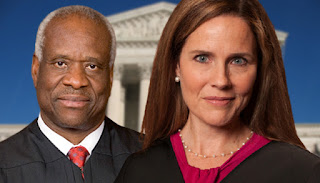Clevelandurbannews.com and Kathywraycolemanonlinenewsblog.com, the most read Black digital newspaper in Ohio and in the Midwest. Tel: (216) 659-0473. Email: editor@clevelandurbannews.com.
By Kathy Wray Coleman, associate publisher, editor in chief. Coleman trained for 17 years as a reporter with the Call and Post Newspaper and is an investigative and political reporter with a background in legal and scientific reporting. She is also a former 15-year public school biology teacher.
Democrats, women's rights groups and Civil Rights organizations, including the NAACP, rallied against her confirmation, but to no avail. She was confirmed by the Senate 52-48, a party line vote with all Democrats opposing her bid to the high court, and all but one Republican supporting her controversial nomination.
Flanked by President Trump and her family members, Coney Barrett, 48, was symbolically sworn in Monday night on the South Lawn of the White House by fellow justice Clarence Thomas, a conservative and the only Black on the nation's highest court.
Her lifetime appointment to the court creates a 6-3 conservative majority.
"The oath that I have solemnly taken tonight means at its core that I will do my job without any fear or favor, and that I will do so independently of both the political branches and of my own preferences," a newly confirmed Justice Coney Barrett said.
A George H.W. Bush appointee, Thomas has a strained relationship with Black America, given his conservative stances and rulings that critics say marginalize Blacks, women and other disenfranchised groups.
His 90s confirmation hearings were marked by scandal and claims by Anita Hill of sexual harassment on the job, Hill testifying before the Senate during the hearings that Thomas, who called the proceedings a high tech lynching, harasses Black women.
Prior to her confirmation to the Supreme Court, Coney Barrett served as a judge on the United States Court of Appeals for the Seventh Circuit in Chicago from 2017 to 2020.
President Trump announced at a rally in North Carolina late last month that he would be nominating a woman to replace associate justice Ruth Bader Ginsburg, a liberal justice appointed to the court by president Bill Clinton in 1993 who died Sept 18 following a courageous battle with pancreatic cancer.
"I will be putting forth a nominee next week. It will be a woman," Trump said at a campaign rally in Fayetteville, North Carolina in September before he announced that person would be Coney Barrett. "I think it should be a woman because I actually like women much more than men."
At her death Ginsburg, 87, was one of four liberals on the Supreme Court, and one of three females, along side of Justices Elena Kagan and Sonia Sotomayer, both of them liberals like Ginburg, and appointed by a Democratic president too, but by president Barack Obama, the nation's first Black president.
Ginsburg was the second woman to serve on the court, after Sandra Day O'Connor.
She was considered a judicial icon on issues ranging from abortion, voting and Civil Rights, to same sex marriage, immigration, healthcare, affirmative action and desegregation.
Coney Barrett will assume her seat on the court just one-week before the presidential election, Trump losing in national polls to Biden and in nearly all of the swing states. She will get to rule momentarily on challenges to election procedures and, within months, on whether to dismantle the Affordable Care Act, Obama's signature legislation, a negative decision of which will throw tens of thousands of people off healthcare.
Challenges to the upcoming election will also go before a supremely conservative court that will also hear property rights issues, voting discrepancies, and so many other matters consequential to women, the Black community and other vulnerable groups.
Coney Barrett has been outspoken against the Affordable Care Act and same sex marriage and this week she will join justices in ruling on whether they will take up a Mississippi case that could lead to the court subsequently overturning Roe. v. Wade, the 1973 landmark Supreme Court case that made abortion legal in America









